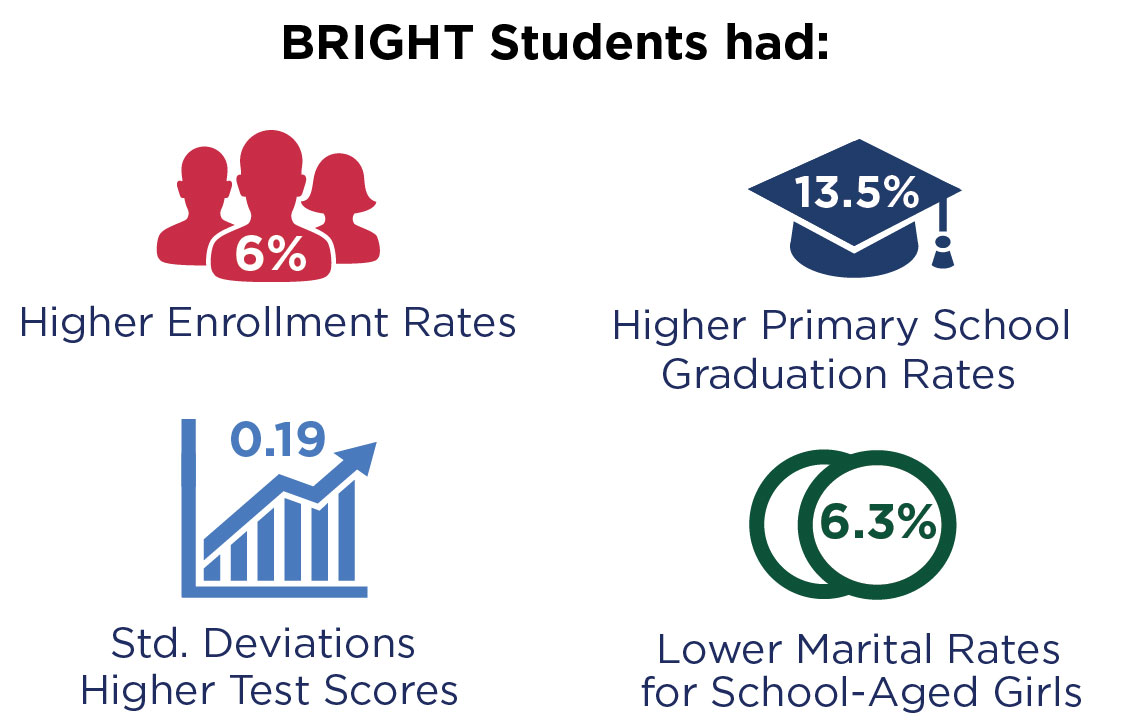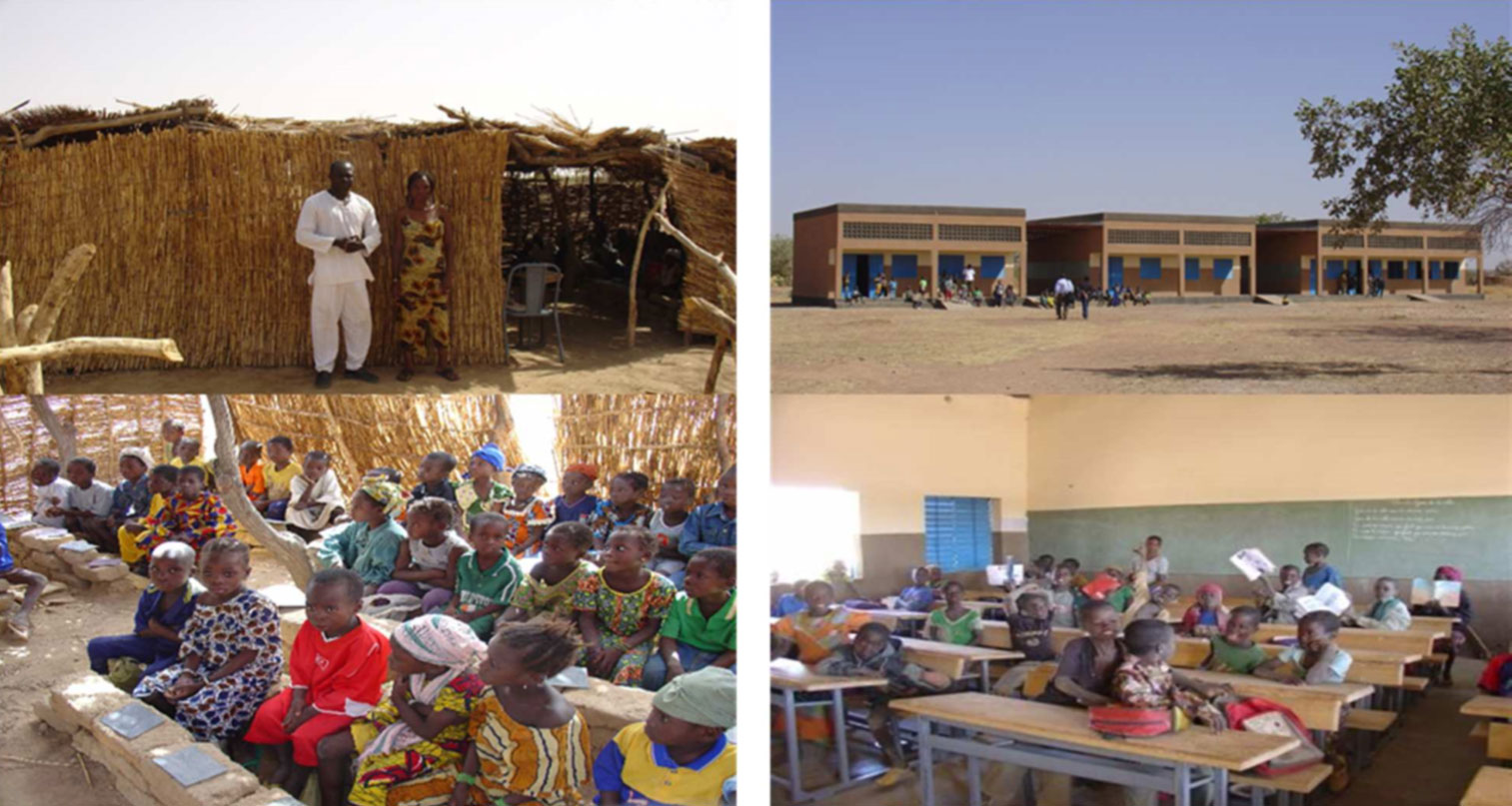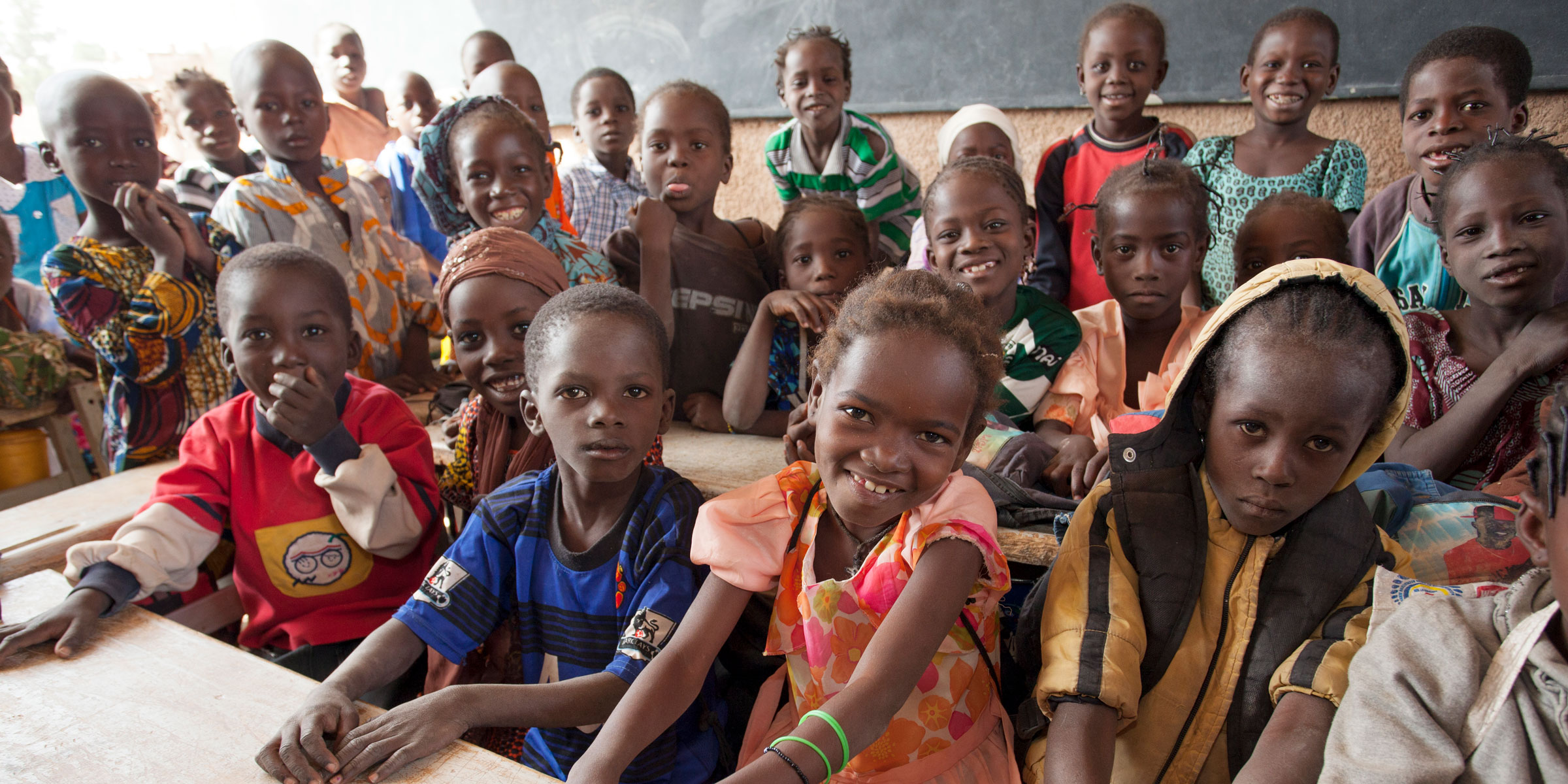Program Overview
MCC's $480.5 million Burkina Faso Compact (2009-2014) included a $28.8 million Burkinabe Response to Improve Girls' Chances to Succeed (BRIGHT II) Project. The Project was based on the theory that improving education infrastructure would improve access to education, particularly for girls. The Project constructed 396 classrooms for grades 3-6 in 132 schools and funded ancillary educational needs for students (e.g. latrines, school supplies, and food) and adults (e.g. teachers' housing and gender-sensitivity training).
Evaluator Description
MCC commissioned Mathematica Policy Research (MPR) to conduct an independent final impact evaluation of the BRIGHT II project. Full report results and learning: https://data.mcc.gov/evaluations/index.php/catalog/92.
Key Findings

Enrollment
- The program improved student enrollment rates by 6% for both boys and girls, with girls showing the larger enrollment rate increase (10.3%).
Test Scores
- Students, especially girls, in BRIGHT schools scored higher on tests compared to non-BRIGHT school students, likely due to BRIGHT students' longer duration of attendance.
Graduation Rates
- Children in BRIGHT communities were substantially more likely to complete primary school, as evidenced by a 13.5% increase in graduation rates compared to non-BRIGHT schools.
Education vs. Employment
- Early entry into the workforce negatively impacts girls' school completion rates. BRIGHT II kept both male and female children and young adults in school rather than the workforce.
Marriage
- School-age girls from communities with BRIGHT schools had a 6.3% lower marital rate than girls from non-BRIGHT communities, demonstrating a positive impact on the value BRIGHT families place on girls' schooling and success.
Evaluation Questions
The final impact evaluation was designed to answer the following questions:- 1 How did BRIGHT II impact students' enrollment rates?
- 2 How did BRIGHT II impact students' test scores?
- 3 How did BRIGHT II impact students' primary-school graduation rates?
- 4 How did BRIGHT II impact students' education versus labor/employment rates?
- 5 How did BRIGHT II impact girls' marital rates?
- 6 Did girls experience different BRIGHT II impacts than boys?
Detailed Findings
Enrollment
Students from communities with BRIGHT schools enrolled in school 6% more than students from communities without BRIGHT schools. In particular, girls in the former group enrolled 10.3% more than girls in the latter. This more easily enabled girls in the former group to delay marriage, parenting, and/or employment.Test Scores
Academic skills were measured by administering math and French tests to students in BRIGHT and non-BRIGHT communities. Standard deviation values were determined by combining math and French test scores and normalizing by the age of the student, then comparing BRIGHT and non-BRIGHT communities. BRIGHT students scored measurably higher on math and French tests (0.19 standard deviations higher) than students from non-BRIGHT communities. Moreover, girls from BRIGHT communities scored .08 standard deviations higher on the tests than boys from BRIGHT communities. The significant positive impact on test scores was likely due to the improved school infrastructure, which resulted in longer retention rates for BRIGHT students. In other words, BRIGHT students stayed in school longer, and therefore achieved higher levels of education and higher test scores.Graduation Rates
Students from communities with BRIGHT schools completed primary school 13.5% more than students from communities without BRIGHT schools. This positive impact on graduation rates suggests that the BRIGHT II project successfully improved problems of accessibility and community engagement that had formerly resulted in low primary school completion rates. This finding demonstrates that the BRIGHT II project achieved one of its ultimate goals of keeping children, especially girls, in school longer.Education vs. Employment
Students and young adults aged 13-22 from communities with BRIGHT schools were about 5.5% more likely than their peers from non-BRIGHT communities to continue education rather than begin employment. These longer retention rates demonstrate that the BRIGHT program was effective at promoting education as a top priority for families in BRIGHT communities.Marriage
The impact of the BRIGHT II program is also reflected in measurements of marital rates among school-age girls. In communities with BRIGHT schools, school-age girls were 6.3% less likely to be married than girls from communities without BRIGHT schools. Since low participation in schooling is linked to early marriage, it is likely that BRIGHT II's positive impact on school enrollment and retention rates contributed to lowered rates of early marriage. The fact that girls were delaying marriage also indicates that BRIGHT II's specific offerings motivated families to place higher value on girls' schooling and success.Economic Rate of Return
- N/A MCC Original Estimate
- 3-8% Evaluation-Based Estimate
MCC Learning
- Addressing factors that threaten specifically female education (e.g. care for younger siblings, cultural and religious views, food insecurity, and mothers' low educational levels) helps girls get education rather than enter into early marriage, parenting, and/or employment.
- Beyond improving the quantity of students' access to and facilities for education (e.g. attendance, assessment, and graduation rates), simultaneously addressing local schools' weak educational quality (e.g. curriculum, faculty, and management) should further improve students' learning.
Evaluation Methods
In 2009, MPR used survey data from 2008 to provide a three-year impact evaluation of BRIGHT I (2005-2008), and in 2012 MPR used same-year survey data to provide a seven-year impact evaluation of BRIGHT I and II (2009-2012), since it is difficult to separate the outcomes of the two projects. In 2015, after a 10-year exposure period, MPR produced a final impact evaluation of BRIGHT I and II, which compared access to and facilities for education between BRIGHT- and non-BRIGHT communities. For the evaluation, MPR conducted surveys of households in communities with BRIGHT schools and administered academic tests of the communities' children. MPR also conducted surveys of BRIGHT schools in or near said communities.Household Surveys: MPR selected 291 BF communities with BRIGHT schools. From each community MPR randomly selected 40 households with children aged 13-22. MPR then surveyed about those children's school enrollment rates, labor and employment history, marital rates, and other factors.
Test Scores: MPR administered math and French tests of the aforementioned students from the household surveys.
School Surveys: MPR selected the schools within ten kilometers of the aforementioned communities from the household surveys. From the resulting 332 primary and 103 secondary schools, MPR surveys evaluated those schools' buildings, supplies, personnel, and other factors.

A traditional school with a basic structure (top) and lack of proper desks and chairs for students (bottom). In contrast, the pictures on the right show a newly-constructed BRIGHT school with modern brick structure (top) and classrooms with student desks and chairs (bottom).
2019-002-2221-01


